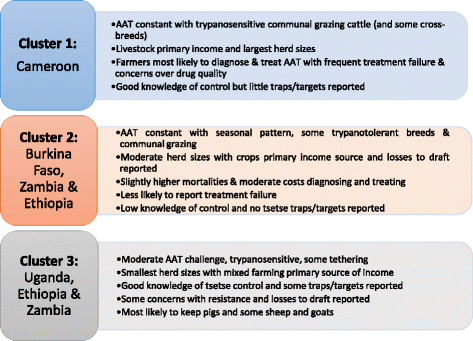Assessment of animal African trypanosomiasis (AAT) vulnerability in cattle-owning communities of sub-Saharan Africa
- PMID: 26825496
- PMCID: PMC4733274
- DOI: 10.1186/s13071-016-1336-5
Assessment of animal African trypanosomiasis (AAT) vulnerability in cattle-owning communities of sub-Saharan Africa
Abstract
Background: Animal African trypanosomiasis (AAT) is one of the biggest constraints to livestock production and a threat to food security in sub-Saharan Africa. In order to optimise the allocation of resources for AAT control, decision makers need to target geographic areas where control programmes are most likely to be successful and sustainable and select control methods that will maximise the benefits obtained from resources invested.
Methods: The overall approach to classifying cattle-owning communities in terms of AAT vulnerability was based on the selection of key variables collected through field surveys in five sub-Saharan Africa countries followed by a formal Multiple Correspondence Analysis (MCA) to identify factors explaining the variations between areas. To categorise the communities in terms of AAT vulnerability profiles, Hierarchical Cluster Analysis (HCA) was performed.
Results: Three clusters of community vulnerability profiles were identified based on farmers' beliefs with respect to trypanosomiasis control within the five countries studied. Cluster 1 communities, mainly identified in Cameroon, reported constant AAT burden, had large trypanosensitive (average herd size = 57) communal grazing cattle herds. Livestock (cattle and small ruminants) were reportedly the primary source of income in the majority of these cattle-owning households (87.0%). Cluster 2 communities identified mainly in Burkina Faso and Zambia, with some Ethiopian communities had moderate herd sizes (average = 16) and some trypanotolerant breeds (31.7%) practicing communal grazing. In these communities there were some concerns regarding the development of trypanocide resistance. Crops were the primary income source while communities in this cluster incurred some financial losses due to diminished draft power. The third cluster contained mainly Ugandan and Ethiopian communities which were mixed farmers with smaller herd sizes (average = 8). The costs spent diagnosing and treating AAT were moderate here.
Conclusions: Understanding how cattle-owners are affected by AAT and their efforts to manage the disease is critical to the design of suitable locally-adapted control programmes. It is expected that the results could inform priority setting and the development of tailored recommendations for AAT control strategies.
Figures




References
-
- PATTEC. A continental plan of action for the eradication of Tsetse and trypanosomosis. The OAU pathway for the PATTEC. Pan African Tsetse and trypanosomosis Global Veterinaria, Eradication campaign. 2000.
-
- Swallow BM. Impacts of trypanosomiasis on African agriculture. PAAT Technical and Scientific Series (FAO). 2000
-
- Pinder M, Authie E. The appearance of isometamidium resistant Trypanosoma congolense in West Africa. Acta trop. 1984;41(3):247–252. - PubMed
Publication types
MeSH terms
LinkOut - more resources
Full Text Sources
Other Literature Sources
Research Materials
Miscellaneous

